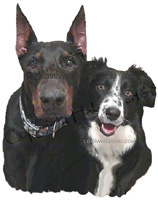A marker, in dog training, is communication to your dog at the instant your dog offers the behavior you wanted. By using a marker, you are telling the dog, “Yes! Right there! That’s the behavior I want!” So it’s a very specific moment, an instant in a chain of action that we want to communicate to the dog, “You’re getting a food reward for THAT.” Markers, therefore, and not used for broad type behaviors like calling a dog. No. They are used for specific behaviors where we freeze-frame the moment.
An example of such is the subject of this video. My dog was lying down when I was giving him a hand signal to sit. You’ll see in this video his right front leg was just beginning to stretch out so he could lie down, but I clicked prior to tell him he already was in the correct position. That is how a marker is best used. For precision work.
Charging a marker, whether it is a word like “Yep,” a clicker or other sound, a flashing light, or even the point of a finger is easy and essential. Doing it prepares a dog for the next step: responding to a marker when learning behaviors. I will explain the process with a clicker as my marker of choice, but you can substitute the marker you chose to use.
 Take the dog to a place in the house that is quiet. Have training food at the ready, in a bait bag or take a hand full from a nearby bowl. Keep the food out of sight. If in your hand, keep your hand closed and still by your side or behind your back. When your dog is nearby, click. As soon as he looks at you, feed him the treat. Repeat this five times, but make sure you are doing this at variable time intervals. Not every 5 seconds, for example, but 5 seconds, then 60 seconds, then 30 seconds, and so on. Then walk a few steps away. Your dog should be intrigued and follow. Again, click, and when the dog looks at you, give him the training food. Repeat this five more times. What we are establishing is the link between the sound and the immediate reward of a food reward.
Take the dog to a place in the house that is quiet. Have training food at the ready, in a bait bag or take a hand full from a nearby bowl. Keep the food out of sight. If in your hand, keep your hand closed and still by your side or behind your back. When your dog is nearby, click. As soon as he looks at you, feed him the treat. Repeat this five times, but make sure you are doing this at variable time intervals. Not every 5 seconds, for example, but 5 seconds, then 60 seconds, then 30 seconds, and so on. Then walk a few steps away. Your dog should be intrigued and follow. Again, click, and when the dog looks at you, give him the training food. Repeat this five more times. What we are establishing is the link between the sound and the immediate reward of a food reward.
Once the dog is aware of the connection between the clicker and training food, your marker is charged. You can now use it for training behaviors. Most importantly, every time you mark a behavior, even if it was a mistake, feed your dog. The marker is a contract between you and your dog that when you use it, he will be rewarded. If you skip doing this, you dilute your marker signal. The marker is what gives you time between the signal marking the behavior and the reward of the food. It’s a precious tool, so use is wisely and appropriately.
Helen Verte Schwarzmann
Contact me
Certified in Training and Counseling
Certified Pet Dog Trainer-Knowledge Assessed
Certified Trick Dog Instructor
Your Board-and-Train Dog Trainer for Fort Myers, Lee county, Naples, Collier county, and southwest Florida
